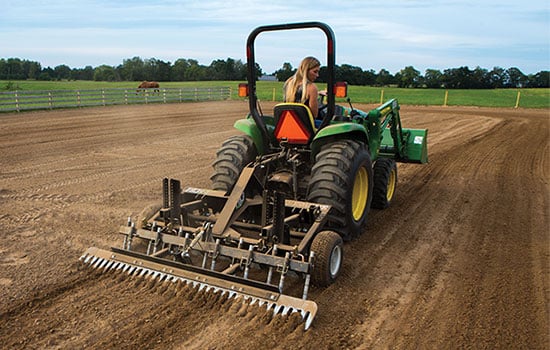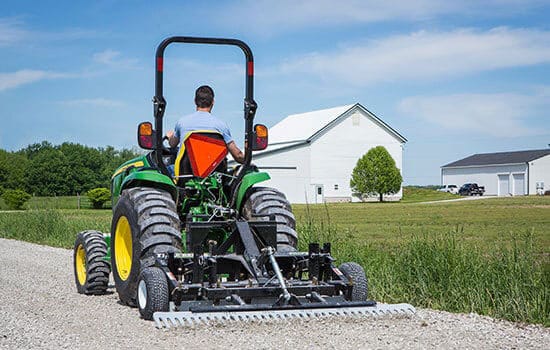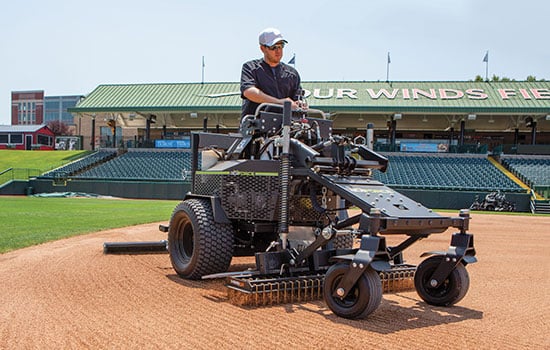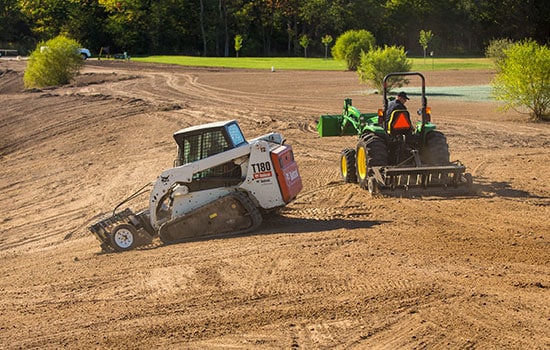Can your ATV/UTV drag handle hard pan? – ABI Dirt
Transcript
Hi everyone. Matt Metzger here with ABI Attachments. Welcome back to another episode of the ABI Dirt. Thank you to all of you who left us some feedback or questions on the last episode on five things to consider when looking for an ATV or UTV drag. a lot of you had some great questions and one thread that worked its way through involved hardpan. Can an ATV and UTV drag tackle hardpan on your property? So on today’s episode, we’re gonna follow up to the last one and talk a little bit about what hard pan is, how it occurs and if you’ve got an ATV or UTV drag, what you can do with that drag to crack through that hard surface in order to get your work done.
Okay, so first up, what is hard pan? Hard pan is just a dense layer of soil. A dense layer of soil can happen either naturally or manmade. In natural circumstances, normally its below your top soil level. And I know some of us have more topsoil than others, right? But its just a very dense layer of soil that is caused by different soil sizes and particles kinda binding and fusing together. Now, when it happens naturally, sometimes it can become impervious to water because those soil particles are so tightly bound together. When its manmade, its because of things that you and I do every single day, like just driving across our gravel drive. Sometimes it can also happen if you’ve got either a food plot or a garden situation that you’ve plowed or disk again and again and again and what’s beneath that surface that you’ve been working up actually gets compacted which means its not draining quite as well, right? So it creates problems with drainage. It creates problems with erosion and it creates problems for you in gravel context because now you’ve got hard pan across a gravel surface that you can’t break into, any gravel you put on top is getting pushed out to the side and your potholes and wash board are getting pretty nasty at this point.
Now, if you’ve got hard pan in a soil context, let’s say you’re talking food plots and gardens at this point or if you’re trying to put in some new lawn somewhere and you’re just dealing with some hard pan surfaces. There are some things that you can add to the soil to make your life a little bit easier but you gotta be careful what you’re going to try to grow, right? So hard pan is caused when you’ve got either a high concentration of minerals, like calcium and iron in the soil, that are trying to bind fast to what you’re working with or it could be a high pH level. It could also just be a high clay content because remember clay, the smallest of the soil particles, really close together, there’s not much space in between those soil particles which means the water can’t get through. So if you’re in a context where you’re trying to grow something and its not gravel project you could and check with the authorities and the people that you trust on what you want to add and how much. You could look into adding a larger particles, soil particles to whatever content you’re working with so that you’ve got a more diverse soil mix so that you don’t have that binding issue. Now in gravel context, if you’ve got things like high iron, higher calcium or high clay, you’re just in a really tight spot because you don’t want to add anything like sand to the mix and you already have those large gravel particles on top. So you need to turn to your ATV, UTV drag if that’s what you’re using in order to break up the hard pan. And that’s what we’re getting to next.
So if you remember the last time we got together, we were talking about the weight of a pull-behind drag. So again, if you’ve got a 3 point drag, that’s fantastic. Put down pressure on that 3 point hitch, get the weight of that tool and rip the daylights out of your gravel project. But if you’re working with a pull-behind tool, ATV or UTV, then you don’t have the pleasure of a 3 point hitch system that you can drop down and really push the weight in. You’re relying on the weight of the tool, which is why weight matters so much on pull-behind tools. So you’ve got to make sure that its heavy enough that you can actually get the work done that you want to get done. Remember not so heavy that you can’t actually pull the darn thing, right? So we’ve already got a heavy drag we’re working with but now we’re gonna take it one step further from our conversation last time and talk about weight per contact point, pound per contact point. So, I mean, this is the physics lesson that every cool high school physics teacher to go through where they like lay on the nail board and you put another nail board on top of them and it doesn’t hurt them because everything is distributed, right.
We’re actually trying to do the opposite with this drag so we can get the drag into that hard pan and break it up. So let’s take, for example, our Gravel Rascal Pro. Our Gravel Rascal Pro it comes in multiple sizes, a five and a half is about 340 pounds and has seven scarifiers. So seven of those ripping teeth. So if we want to maximize the weight of the tool by getting the maximum amount of pounds per contact point then what we can do is take three of those seven scarifiers out. Now you’ve only got four contact points. And rather than having that 340 pounds split up on seven which is about 48, 49 pounds per scarifier. Now you’ve bumped it up to 85 pounds per ripping teeth and that should help you get into that hard pan. Again, in this situation, you’d pull the tires off the ground, pull the rake off the ground. All you’re trying to do is maximize the weight per contact point. So you can get into that hard pan. So that’s one trick you can use, no matter what drag you’ve got to maximize the weight per contact point so you can try to dig through that hard surface. Another trick you can also use is to check your angle of engagement. And we’ve talked about this plenty of times here on the ABI Dirt. How if you’ve got a component that is facing to the rear, well, at that point, you’re just kind of grooming and feathering. And if you’ve got a contact point that is perpendicular to the ground, we were just kind of scratching the surface. But if you really want to maximize the aggressiveness and the weight of that tool, then once you knew his angle that contact point forward the direction that you’re moving about 30 degrees, 40 degrees so it can really dig in because, and again think of your wood chisel, right? As you’re running that chisel over the plane if you’re digging it in, its going to dig, its going to gouge and the material itself will actually help and pull it in. So maximize your pounds per contact point and get that angle of contact right so that you can help yourself out in using the weight of your a pull-behind drag to get through that hard pan.
That’s all I’ve got for today, everyone. I hope that was helpful. Like I said, just a really short operational tip on how to make the most out of that pull-behind behind drag you’ve already got to crack through the hard pan. Yes, it will take time. Yes, you’re going to have to experiment a little bit on how to dial in those scar fires to really rip up before you put the rest of the setback in but I hope this is helpful. For those of you who are experienced some nasty storms here recently, I hope you’re all safe and warm. That’s kind of nasty out there. For the rest of, no bragging about the warm weather but I would love it if you would brag about the tips and tricks that you know for your pull-behind drags. So if you’ve got a way that you use your Gravel Rascal Pro and ABI product or a non ABI product. If you’ve got a trick that you use to get through the hard pan on your property we’d love to know about it. Not just because we want to say hi but also because we’d love for you to share your knowledge, your insight with everyone else. So leave a comment below, make sure to say hi and I’ll see you next time.



